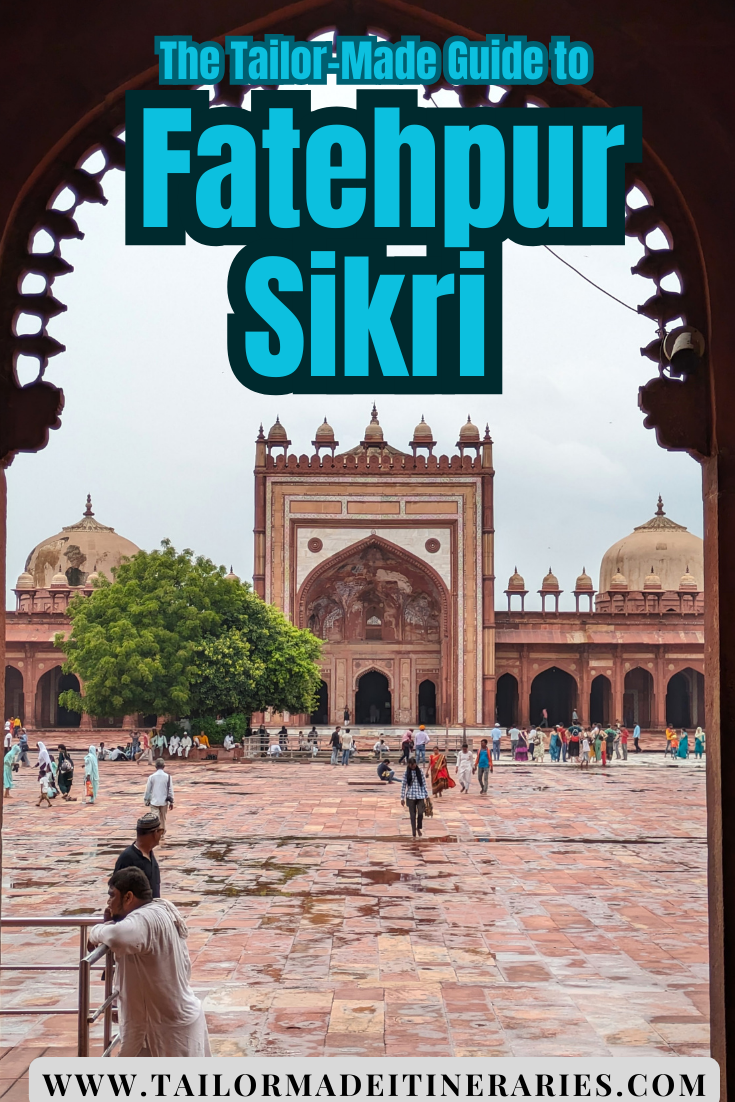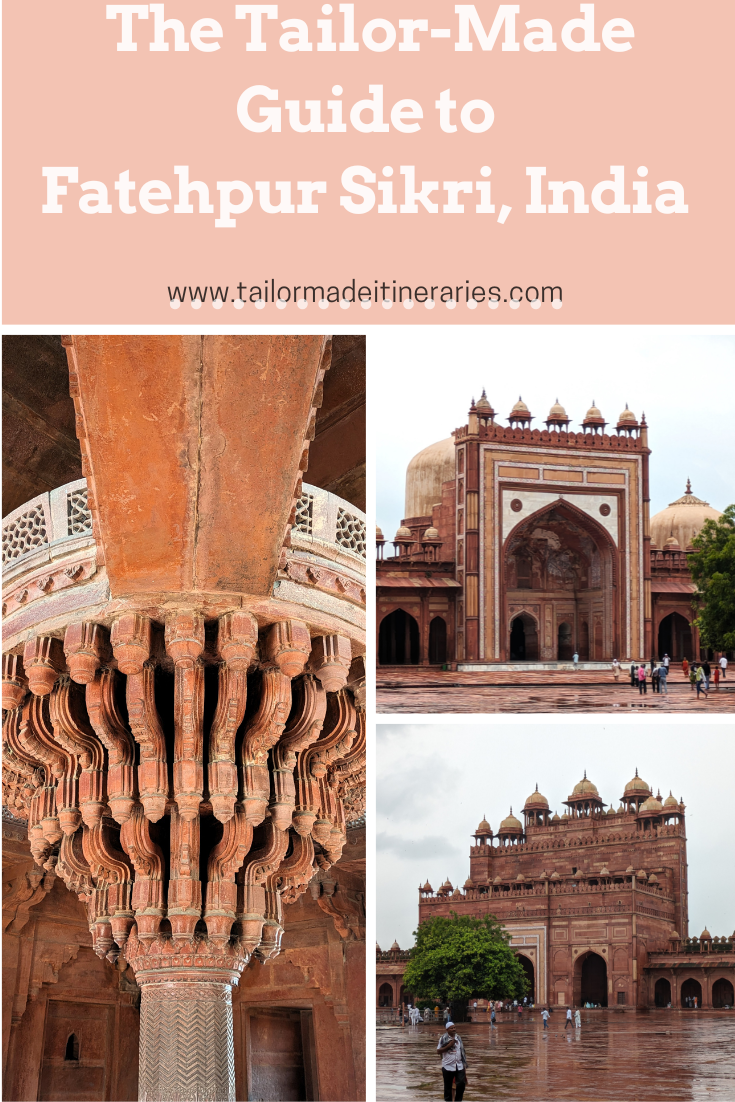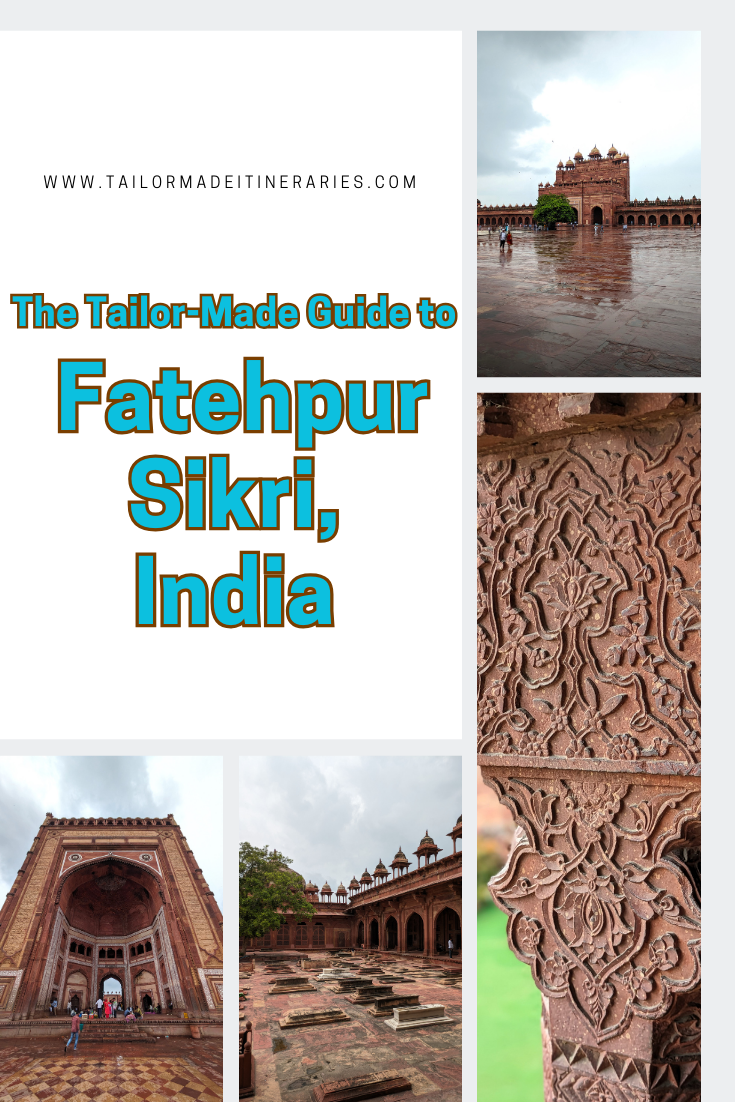The Tailor-Made Guide to Fatehpur Sikri, India
- Barry Pickard

- Oct 14, 2024
- 9 min read
Updated: Oct 22

**Disclosure: This post contains affiliate links. Regardless of this, please be advised that all opinions expressed in this blog post are genuine and authentically my own.**
Author: Barry Pickard
Hi, I'm Barry, the owner of Tailor-Made Itineraries and I have been designing bespoke self-guided tours for adventurous and curious travellers since 2015. I am a history graduate with a passion for travel.
I created this blog to show, through my own adventures, how you can have an incredible travel experience as an independent traveller, giving you the information to navigate the world with confidence.
Contents

Where is Fatehpur Sikri & How to Get There
Have you ever wondered what it feels like to walk through a city that time forgot? Let me take you on a journey to Fatehpur Sikri, a place where history whispers through every red sandstone structure. Fatehpur Sikri was built by Emperor Akbar in 1571, and this city was meant to be a grand capital, but it was abandoned due to water scarcity. Today, it stands as a testament to the architectural brilliance of the Mughal era, frozen in time.

As you step into Fatehpur Sikri, the first thing that hits you is the sight of the majestic Buland Darwaza, towering above with its intricate carvings. The air is filled with the faint scent of ancient stone and the distant echoes of past grandeur. Can you imagine the bustling life that once filled these courtyards and gardens? Before Akbar’s reign, this site was a thriving village known as Sikri, with a history stretching back to the Sunga and Sakarwar Rajputs.

I remember my first visit vividly. Walking through the grand palace, courtyards, and ceremonial gates, I could almost hear the footsteps of emperors and saints. The artificial lake and large mosque, all constructed from local red sandstone, tell tales of a city that was the first Mughal planned city. Akbar’s vision was not just architectural but cultural, aiming to blend different cultures and religions harmoniously.
If you’re an independent traveler like me, looking for a place rich in history and culture, Fatehpur Sikri is a must-visit. This “City of Victory,” named after Akbar’s triumphant Gujarat campaign in 1573, offers a unique glimpse into the past. Trust me, you won’t be wasting your time here. I’ve explored many historical sites, but Fatehpur Sikri holds a special place in my heart. So, pack your bags and get ready to step back in time with me.
Planning an independent trip to Fatehpur Sikri and northern India?
All information in this post is based on my own experience travelling through India, backed by extensive research to bring you everything you need know to have your own amazing experience.
Don’t forget that Tailor-Made Itineraries delights in creating bespoke self-guided tours. So, if this guide to Fatehpur Sikri, India, appeals to you, reach out to me by email. I would be more than happy to design a self-guided tour around your requirements incorporating the stunning sights of Fatehpur Sikri, or indeed, a general tour of northern India.
Guide to Fatehpur Sikri Fort, India
Diwan-E-Aam
The Diwan-E-Aam, also known as the Hall of Public Audience, is a pavilion-like rectangular structure which served as the designated hall where emperors met with the public. Emperor Akbar would sit here every morning to listen to the petitions and concerns of the general public.

Tailor-Made Top Tips:
Get your tickets for the palace complex at the gate before entering the Diwan-E-Aam. At the time of my visit, the ticket cost around 600 rupees for foreigners and 50 rupees for Indians. Note that you do not need a ticket to enter the Buland Durwaza area only the palace complex.
I would advise you to hire a guide. There are a number of buildings to visit, with interesting stories to discover, which can be brought to life by a good guide. They can also guide you through the process of purchasing fabric to use as an offering at the Holy Tomb of Hazrat Salim Chishti. There should be a number of guides around the entrance to the palace complex. Expect to pay around 500 rupees.
Diwan-E-Khas
The Diwan-E-Khas, also known as the Hall of Private Audience, is a remarkable structure which served as a special hall for private meetings and discussions. It was the place where the emperor received important guests such as kings, ambassadors, and nobles.

The Diwan-E-Khas is not a large structure but stands out due to its unique design, with a massive central column encircled by brackets supporting a stone throne platform.

The Pachisi Courtyard
The Pachisi Courtyard in front of the Panch Mahal is paved with large square slabs of red sandstone, arranged in the form of a symmetrical cross, resembling a board for the traditional Indian board game, Pachisi. Legend has it that Akbar would use women as human game pieces and have them stand on this ‘board’.

If you are enjoying this post, remember and subscribe to my mailing list to receive my latest blog posts.
Panch Mahal
The Panch Mahal draws its inspiration from the architecture of Buddhist temples, and its name translates to ‘Five-level Palace’. The ground floor has 84 columns, which originally would have had jaali (screens) between them. The pool in front of the Panch Mahal is called the Anoop Talab.


Jodha Bai’s Palace
Emperor Akbar commissioned this palace in 1569 for his favourite queen consort, Mariam-uz-Zamani, commonly known as Jodha Bai. It served as the residential quarters for the empress and her newborn son, Prince Salim (later known as Emperor Jahangir).

The palace reflects a fusion of Hindu and Persian architecture, constructed primarily from red sandstone. Inside, you’ll find a Hindu temple and a Tulsi math (used for worship by Jodha Bai).

Read on to discover the Royal entrance, a sufi landmark and the highest gate in India!
King’s Gate
The King’s Gate, also known as the Badshahi Darwaza, was built in 1602 AD, and commemorates Akbar’s victory in Uttar Pradesh and Gujarat.

Tailor-Made Top Tip:
Dress code - before walking through the gate and into the courtyard, you will be required to remove and leave your shoes. Also, if you are wearing shorts, you will be required to cover your legs with a sarong-type length of fabric that you can borrow from a stall on the approach to the gate.

Holy Tomb of Hazrat Salim Chishti
The decision of Akbar to build the city where he did, was influenced by the Sufi saint Sheik Salim Chishti, who had foretold the birth of a royal son there. Salim Chishti had lived in a cavern on the ridge at Sikri. Emperor Akbar built this mausoleum during the years 1580 and 1581 as a mark of his respect for Salim Chisti.

The main tomb building is enclosed by delicate marble screens on all sides., with the structure being beautifully carved with an ivory-like appearance.
An ebony “chhaparkhat” enclosure surrounds the marble cenotaph, usually covered by a green cloth. This wooden canopy is encrusted with mother-of-pearl inlay mosaic. The practice of covering the cenotaph holds deep spiritual and cultural significance, showing respect and veneration to the saint. Tying string on lattice work is also undertaken, with each tied thread representing a wish, prayer, or desire.
Buland Darwaza
Fatehpur Sikri is perhaps most famous for the Buland Darwaza, the highest gate in India and reputably in the world. The “Door of Victory” stands as a magnificent entrance to the mosque quadrangle and commemorates Akbar’s triumphant victory over Gujarat, while showcasing Mughal architecture at its finest.

The Buland Darwaza stands 40 meters high and 51 meters from the ground, spanning 15 stories. The approach involves 42 steps leading to its grandeur.

An Islamic inscription in Persian on the eastern archway recounts Akbar’s conquests.
It reads: “Isa (Jesus), son of Maryam (Mary), said: 'The world is a Bridge, pass over it, but build no houses upon it. He who hopes for a day may hope for eternity, but the World endures but an hour.”

Where is Fatehpur Sikri Located and How to Get There
The distance from Agra to Fatehpur Sikri is less than 40 kilometres to the west, in the state of Uttar Pradesh, making it an ideal day trip if you are also visiting the Taj Mahal, where you could visit one of the Wonders of the World at sunrise, then travel to the City of Victory. It takes just under an hour to drive to from Agra to Fatehpur Sikri. If you are travelling India’s Golden Triangle (Delhi, Agra and Jaipur), then it makes sense to visit Fatehpur Sikri when you are journeying between Agra and Jaipur.

Hire a Driver: Hiring a driver is a more economical and personalised way of travelling around Rajasthan than booking with a bus tour operator. This is my own preferred mode of transport when travelling in India, and Rajasthan in particular. I used the excellent services of Vivek at Just To Travels to organise this for me – website & email.
You can also reach Fatehpur Sikri by rail, with the train from Agra Fort taking an hour to reach the town.
Getting Around Fatehpur Sikri
Note that private cars can’t park near the palace entrance. Instead, there is a large carpark near the Gullistan Tourist Complex, just on the main road as you enter the town from the direction of Agra. There are a number of souvenir shops there also. Walk past these shops to the bus terminal and buy your return bus ticket. The bus will shuttle you to the palace entrance, and the return shuttle will pick you up from the area between the palace and the King’s Gate.

If you are enjoying this post, remember and subscribe to my mailing list to receive my latest blog posts.
The Best Time to Visit Fatehpur Sikri
The weather between November and March tends to be cool and dry, making the winter season an ideal time to visit. Of course, this means that the site will be busier with tourists. I visited during the monsoon season in August. It was hot and there was one downpour while I was there, but there is plenty of shelter, and I wouldn’t be put off visiting this architectural marvel during the summer or monsoon months.

As for its opening hours, the site is open from around sunrise to sunset, which gives you the opportunity to visit early to avoid the crowds.
How Long Should You Stay at Fatehpur Sikri
I would advise you plan on spending three to four hours exploring Fatehpur Sikri, especially if you hire a good guide to show you around when you are there.
Where to Stay When Visting Fatehpur Sikri
When visiting Fatehpur Sikri, I'd avise staying at a hotel in nearby Agra. I stayed at the Double Tree by Hilton Hotel Agra and found it very comfortable, with excellent service. Centrally located, with lovely restaurants and bar, it was an ideal base for my Agra and Fatehpur Sikri explorations.

Agra is a very popular tourist destination, so you will find a whole range of hotels for all pockets and tastes, with all the main global and Indian hotel brands well represented in the city, such as the Courtyard by Marriott Agra, the ITC Mughal, and The Oberoi Amarvilas Agra.
Conclusion
Visit Fatehpur Sikri and enjoy glimpses of India’s rich past. As you wander through these sandstone marvels, remember that this ghost town not only holds architectural treasures but also stories of love, faith, and empire. So, venture beyond the beaten path, and let Fatehpur Sikri weave its enchantment around you.
Related Blog Posts
If you would like more information on travelling India's Golden Triangle, please view the Tailor-Made Itineraries posts below:
Comment below and let me know if you have visited Fatehpur Sikri and what you thought of it.
Don’t forget that Tailor-Made Itineraries delights in creating bespoke self-guided tours. So, if this guide to Fatehpur Sikri, India, appeals to you, reach out to me by email. I would be more than happy to design a self-guided tour around your requirements incorporating the stunning sights of Fatehpur Sikri, or indeed, a general tour of northern India.
Join me next time on my adventures when I visit the East Bay area of California. Tailor-Made Itineraries posts every two weeks, and you can subscribe to the latest blog and newsletter here. Until then, happy reading and safe travels.
Barry
Contact Me: tailoritineraries@gmail.com
Tailor-Made Itineraries creates one-of-a-kind bespoke self-guided travel itineraries for adventurous and curious travellers.
These self-guided tours deliver a personalised and exciting holiday experience that takes the effort out of trip planning.
Fatehpur Sikri Map



















































Comments